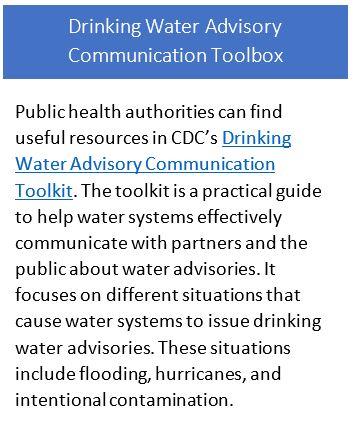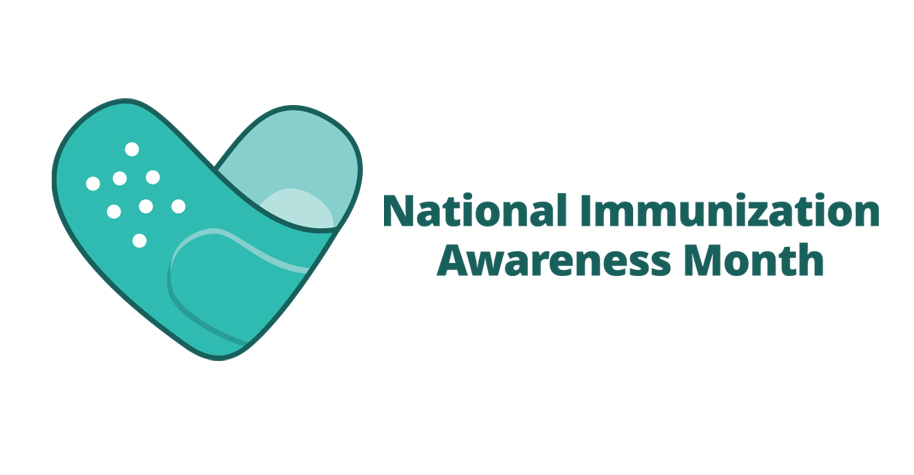
August is National Water Quality Month
The United States has one of the safest and most reliable drinking water systems in the world. However, emergencies, such as natural (e.g., hurricanes, floods, and droughts) and man-made disasters (e.g., chemical spills), can damage water infrastructure and/or contaminate water supplies.
Safe drinking water is essential to the health and wellbeing of communities. Every year, about 7.2 million people get sick in the U.S. from diseases spread through water. Knowing how to ensure your access to safe water during & after emergencies can protect you from getting sick.
Ensuring Access to Safe Water
Depending on the emergency, your water may be safe to use for personal hygiene and handwashing, but unsafe for drinking and cooking. Or it could be unsafe to use for any reason.
Authorities use drinking water advisories to inform communities about public health threats related to drinking water. Advisories are designed to inform consumers about the situation and provide recommendations on what to do. Advisories usually include one of these warnings: Boil Water Advisory, Do Not Drink Advisory, and Do Not Use Advisory.
If tap water is unavailable or unsafe to drink or use after an emergency, it’s important to know how to make your water safe and where to find alternative water sources inside your home.
Unopened commercially bottled water is the safest and most reliable source of water in an emergency. If bottled water is unavailable, you can make your water safe through boiling, disinfection, filtration, or ultraviolet light.
You may also consider exploring alternative sources of safe water. Water sources can be inside your home (e.g., liquid from canned fruits and vegetables)— or outside your home. Learn about places where you might find sources of water that are safe to use.
Creating an Emergency Water Supply
It’s important to develop a plan to ensure access to clean drinking water at home, the office, the school, or other places where a water-related emergency may occur.
Storing unopened commercially bottled water is one of the most reliable and least expensive sources of water in an emergency. Store at least one gallon of water per person per day for three days for drinking and sanitation. Try to store a two-week supply if possible.
CDC recommends that you keep in mind the following:
- Your local weather/climate: Consider storing more water during summer or if you live in a drought-prone area.
- Special health needs
Set a reminder to replace store-bought water according to their expiration date and bottles of water appropriately bottled at home every 6 months.
Keep a bottle of unscented liquid household chlorine bleach to disinfect your water, if necessary. The label should say it contains between 5% and 9% of sodium hypochlorite.
Considerations for At-Risk Populations
Consider people’s specific health needs and the conditions in the places where they live when communicating about water preparedness.
Access to and use of safe treated water is often influenced by geographical location and/or socioeconomic status. People living near contaminated sources of water (e.g., aging infrastructure, rural, tribal, immigrant, or refugee communities) may face increased exposure to unsafe drinking water.
Certain populations, including infants and children, people with certain medical conditions, pregnant people, and older adults are at a higher risk of suffering from health issues because of the lack of access to safe water.
-
- Infant formula feeding requires safe water to prepare the formula and cleaning supplies to clean bottles, nipples, and other parts. Find more information and resources for emergency preparedness and response personnel, families, and the public to ensure that children are fed safely during an emergency: Infant and Young Child Feeding in Emergencies (IYCF-E) Toolkit | Nutrition | CDC.
- It’s always important to change diapers in a safe, germ-free way, but an emergency can make this difficult. CDC offers guidelines and checklists to help parents, childcare providers, emergency responders, and others learn how to prevent the spread of germs while changing diapers during emergencies.
- Schools, day-care centers, and camps for children can be at risk for outbreaks during an emergency. CDC has available information to help state and local health departments respond to suspected waterborne outbreaks.
- People who are immunocompromised or have a weakened immune system because of a medical condition or medical treatment may be more susceptible to getting sick.
- Adults aged 65 and older are at increased risk of infection and disease from harmful germs because of many factors, including reduced immunity, existing chronic illness, and institutional exposure (e.g., exposures at hospitals and nursing homes). Visit CDC’s Promoting Health for Older Adults to learn about this topic.
Similarly, people with limited access to safe water in their homes, grocery stores, or the means to travel to and haul water may find it difficult or even impossible to prepare a home water supply.
Emergency preparedness authorities should account for their communities’ specific needs when developing response plans. CDC offers customizable and printable tools and templates, which include checklists, fact sheets, and press releases that can be adapted to the needs of each community.
Resources
- CDC – Natural Disasters and Severe Weather
- CDC – Plan Ahead
- CDC- Water, Sanitation, & Hygiene-related Emergencies & and Outbreaks
- CDC – Emergency Water Supply Planning Guide for Hospitals and Healthcare Facilities | Water, Sanitation, & Hygiene-related Emergencies & and Outbreaks | Healthy Water
- EPA – Water Utility Response
- EPA – Develop messages for water emergencies (EPA)
- EPA – Ground Water and Drinking Water
- EPA – Report on the environment: drinking water. Available at: https://cfpub.epa.gov
- Postma J, Butterfield P, Odom-Maryon T, et al. Rural children’s exposure to well water contaminants: implications in light of the American Academy of Pediatrics’ recent policy statement. J Am Acad. Nurse Pract. 2011;23:258–265
- APHA- Public Health Policy- Drinking Water & Public Health in the US
- Ready.gov – Water
Thanks in advance for your questions and comments on this Public Health Matters post. Please note that CDC does not give personal medical advice. If you are concerned you have a disease or condition, talk to your doctor.
Have a question for CDC? CDC-INFO (http://www.cdc.gov/cdc-info/index.html) offers live agents by phone and email to help you find the latest, reliable, and science-based health information on more than 750 health topics.












